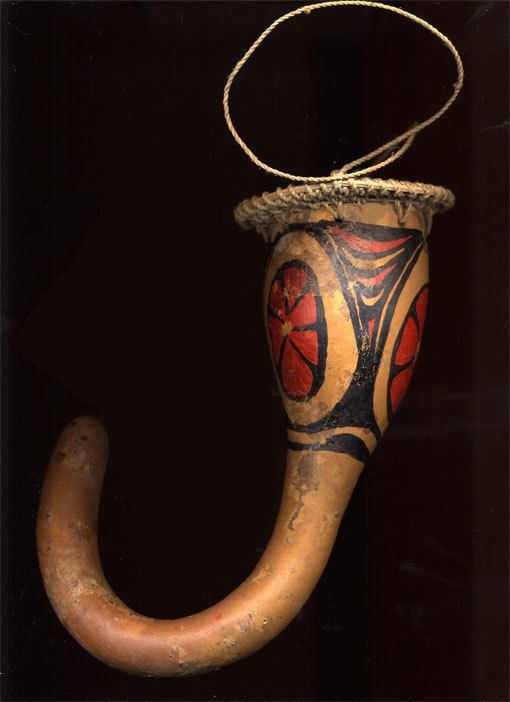 | ||
The koteka, horim, or penis gourd is a penis sheath traditionally worn by native male inhabitants of some (mainly highland) ethnic groups in New Guinea to cover their genitals. They are normally made from a dried-out gourd, Lagenaria siceraria, although other species, such as Nepenthes mirabilis, are also used. They are held in place by a small loop of fiber attached to the base of the koteka and placed around the scrotum. There is a secondary loop placed around the chest or abdomen and attached to the main body of the koteka. Men choose kotekas similar to ones worn by other men in their cultural group. For example, Yali men favour a long, thin koteka, which helps hold up the multiple rattan hoops worn around their waist. Men from Tiom wear a double gourd, held up with a strip of cloth, and use the space between the two gourds for carrying small items such as money and tobacco.
Contents
Traditions
It is traditional clothing in certain New Guinea highlands societies including in the Grand Baliem Valley of Western New Guinea and the Ok Tedi and Telefomin regions of Papua New Guinea. It is worn without other clothing, tied in upward position. The use of penis gourds has also been documented for tropical Africa and northern South America.
Different identification
Many tribes can be identified by the way they wear their koteka. Some wear them pointed straight out, straight up, at an angle, or in other directions. The diameter of the koteka can also be a clue. Contrary to popular belief, there is little correlation between the size or length of the koteka and the social status of the wearer. Kotekas of different sizes serve different purposes: very short kotekas are worn when working and longer and more elaborate kotekas are worn on festive occasions. The koteka is made of a specially grown gourd. Stone weights are tied to the bottom of the gourd to stretch it out as it grows. Curves can be made in it by the use of string to restrain its growth in whatever direction the grower wishes. They can be quite elaborately shaped in this manner. When harvested, the gourd is emptied and dried. It is sometimes waxed with beeswax or native resins. It can be painted, or have shells, feathers and other decorations attached to it.
Sociolinguistically and politically today, the term koteka is used as a name of tribal groups across the highlands of New Guinea, in both West Papua and Papua New Guinea. For example, in West Papua today, there is an Assembly of Koteka Tribes. The term koteka was never used to identify a society or ethnic group before, but it is now commonly known for a tribal group within Melanesia across the highlands of New Guinea.
Sexuality
It is commonly assumed that there is a sexual display element to wearing the koteka; however, according to the locals, kotekas are worn only to cover themselves.
Attempted eradication
In 1971–1972 the Indonesian government launched "Operasi Koteka" ("Operation Penis Gourd") which consisted primarily of trying to encourage the people to wear shorts and shirts because such clothes were considered more "modern." But the people did not have changes of clothing, did not have soap, and were unfamiliar with the care of such clothes so the unwashed clothing caused skin diseases. There were also reports of men wearing the shorts as hats and the women using the dresses as carrying bags.
Eventually the campaign was abandoned. Nevertheless, western clothing is required in government buildings, and children are required to wear western clothing in school.
Different uses
Phallocrypts are decorative penis sheaths worn in parts of New Guinea during traditional ceremonies. They are usually made out of gourds or woven fibers and decorated with feathers, beads, cowry shells, and small metal ornaments. The most elaborate phallocrypts are sold to tourists as souvenirs and are not usually representative of ones actually used in ceremonies.
A phallocrypt can also be a simple ornament hung from male genitalia as part of a cultural expression, for ceremonial use or pure decoration. Among a number of ancient and modern people throughout the Oceanic world, Africa and many parts of the Americas it was (and still is in some places) a common form of ornamentation. Some Aboriginal peoples of Australia wore an ornate carved pearl shell type called a Lonka Lonka. It is hung from the genitals by a twisted thong made of human hair. They are often ornately engraved with mainly geometric patterns and the grooves were colored with reddish ochre. Some South American cultures actually hung heavy, carved jade and other hardstone ornaments from piercings through the skin of their penis and scrotum. These were usually of a temporary ritualistic nature.
